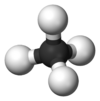Chemistry:Polysulfane
A polysulfane is a chemical compound of formula H
2S
n, where n > 1 (although disulfane (H
2S
2) is sometimes excluded).[1][2][3] Compounds containing 2 – 8 sulfur atoms have been isolated, longer chain compounds have been detected, but only in solution.[4] H
2S
2 is colourless, higher members are yellow with the colour increasing with the sulfur content. In the chemical literature the term polysulfanes is sometimes used for compounds containing –(S)
n–, e.g. organic polysulfanes R1
–(S)
n–R2
.
Structures
Polysulfanes consist of unbranched chains of sulfur atoms terminated with hydrogen atoms. The branched isomer of tetrasulfane H
2S
4, in which the fourth sulfur is bonded to the central sulfur, would be described as trithiosulfurous acid, S=S(–SH)
2. Computations suggests that it is less stable than the linear isomer HS–S–S–SH.[5] The S-S-S angles approach 90° in trisulfane H
2S
3 and higher polysulfanes.[4]
Reactions and properties
Polysulfanes can easily be oxidised, and are thermodynamically unstable with respect to decomposition (disproportionation) readily to H
2S and sulfur:
- 8 H
2S
n → 8 H
2S + (n – 1) S
8 (in this chemical reaction, S
8 is cyclo-octasulfur, one of the allotropes of sulfur)
This decomposition reaction is catalyzed by alkali. To suppress this behavior, containers for polysulfanes are often pretreated with acid to remove traces of alkali.[6]
In contrast to the thermodynamic instability of polysulfates, polysulfide anions form spontaneously by treatment of S2− with elemental sulfur:
- S2− + (n – 1) S → [S
n]2−
Beyond H
2S and H
2S
2, many higher polysulfanes H
2S
n (n = 3 – 8) are known.[7] They have unbranched sulfur chains. Starting with disulfane H
2S
2, all known polysulfanes are liquids at room temperature. The density, boiling point and viscosity correlate with chain length. Physical properties of polysulfanes are given in the table below.[6]
| Chemical formula | Name | Density at 20 °C (g/cm3) | Vapour pressure | Extrapolated boiling point |
|---|---|---|---|---|
| H 2S |
Sulfane | 1.363 g/dm3 (gas) | 1740 (kPa, 21 °C) (gas) | −60 °C (−76 °F) |
| H 2S 2 |
Disulfane | 1.334 | 87.7 mmHg (11,690 Pa) | 70 °C (158 °F) |
| H 2S 3 |
Trisulfane | 1.491 | 1.4 mmHg (190 Pa) | 170 °C (338 °F) |
| H 2S 4 |
Tetrasulfane | 1.582 | 0.035 mmHg (4.7 Pa) | 240 °C (464 °F) |
| H 2S 5 |
Pentasulfane | 1.644 | 0.0012 mmHg (0.16 Pa) | 285 °C (545 °F) |
| H 2S 6 |
Hexasulfane | 1.688 | ? | ? |
| H 2S 7 |
Heptasulfane | 1.721 | ? | ? |
| H 2S 8 |
Octasulfane | 1.747 | ? | ? |
They also react with sulfite and cyanide producing thiosulfate and thiocyanate respectively.[6]
Polysulfanes can be made from polysulfides by pouring a solution of a polysulfide salt into cooled concentrated hydrochloric acid. A mixture of metastable polysulfanes separates as a yellow oil, from which individual compounds may be separated by fractional distillation. Other more selective syntheses are:
- Na
2S
n + 2 HCl → 2 NaCl + H
2S
n (n = 4, 5, 6) - S
nCl
2 + 2 H
2S
m → 2 HCl + H
2S
n+2m
The reaction of polysulfanes with sulfur dichloride or disulfur dichloride produces long-chain dichloropolysulfanes:
- 2 SCl
2 + H
2S
n → 2 HCl + S
2+nCl
2 - 2 S
2Cl
2 + H
2S
n → 2 HCl + S
4+nCl
2
The reaction with a sulfite salt (a base) quantitatively decomposes the polysulfane to produce thiosulfate and hydrogen sulfide:
- (n – 1) SO2−
3 + H
2S
n → (n – 1) S
2O2−
3 + H
2S
References
- ↑ IUPAC, Compendium of Chemical Terminology, 2nd ed. (the "Gold Book") (1997). Online corrected version: (2006–) "polysulfanes". doi:10.1351/goldbook.P04753
- ↑ Wiberg, E.; Holleman, A. F.; Wiberg, Nils (2001) (in en). Inorganic Chemistry. San Diego : Academic Press; New York : De Gruyter. ISBN 978-0-12-352651-9. OCLC 48056955. https://books.google.com/books?id=Mtth5g59dEIC.
- ↑ Greenwood, N. N.; Earnshaw, A. (2012-12-02) (in en). Chemistry of the Elements. Boston, Massachusetts, MA: Elsevier. ISBN 978-0-08-050109-3. OCLC 48138330. https://books.google.com/books?id=EvTI-ouH3SsC.
- ↑ 4.0 4.1 R. Steudel "Inorganic Polysulfanes H2Sn with n > 1" in Elemental Sulfur and Sulfur-Rich Compounds II (Topics in Current Chemistry) 2003, Volume 231, pp 99–125. doi:10.1007/b13182
- ↑ Laitinen, Risto S.; Pakkanen, Tapani A.; Steudel, Ralf (1987). "Ab initio study of hypervalent sulfur hydrides as model intermediates in the interconversion reactions of compounds containing sulfur–sulfur bonds". J. Am. Chem. Soc. 109 (3): 710–714. doi:10.1021/ja00237a012.
- ↑ 6.0 6.1 6.2 Greenwood and Earnshaw, p. 683
- ↑ R. Steudel "Inorganic Polysulfanes H2S2 with n > 1" in Elemental Sulfur and Sulfur-Rich Compounds II (Topics in Current Chemistry) 2003, Volume 231, pp 99-125. doi:10.1007/b13182
 |








